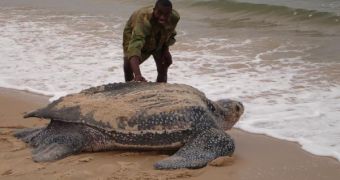The longest migration previously known was that of the Arctic tern (Sterna paradisaea), which nests in the Arctic zone, in the tundra region, and winters in the Antarctica (when there is the Austral summer). Due to this 19,000 km (12,000 mi) journey, the bird sees two summers annually and more daylight than any other creature on the planet.
But this is a child play compared to what the leatherback sea turtle is capable of doing: 12,774 miles (20,558 kilometers) across the Pacific Ocean, and that by flippers, not by wings! It's the longest ever recorded migration of any sea vertebrate and was signaled in the journal "Chelonian Conservation and Biology."
Satellite tracking 9 females of leatherback turtles, from a nesting population on the beaches of Jamursba-Medi (Papua, Indonesia), revealed that one of the large reptiles started its trek in Indonesia's warm tropical waters in the summer of 2003, crossed the Equator and faced strong and swift currents close to Hawaii's Kauai island. The turtle dived into the cold dark water at 3,300 ft (1,000 m) from time to time. 647 days later, it reached the cool jellyfish rich waters of the Pacific Northwest, off Oregon coast.
The leatherback sea turtle is the world's largest living turtle: its body is 6.6 ft (2 m) long and weighs up to 2,000 pounds (900 kg). Its relatives during the dinosaur era were thrice larger!
The metabolism of the leatherback turtle is about four times higher than that of other large reptiles, as this species has counter-current heat exchangers, and a fatty insulation like in whales. That's why it has a body temperature up to 18 ?C (32 ?F) above that of the surrounding water, explaining its presence in such cold waters, like off Norway, Labrador, and Alaska, where other reptiles would freeze.
Some say that the leatherback can generate its own body heat (like a mammal). Some larger poikilotherms, because of the large volume compared to the surface area ratio, can keep relatively high body temperatures, a phenomenon called gigantothermy (inertial homeothermy), seen from sea turtles and large sharks, and probably encountered in many dinosaurs and ancient sea reptiles (like ichthyosaurs and plesiosaurs).
Leatherbacks are also "patch feeders," feeding only when it encounters food concentrations.
"Like large whales, their immense size allows them to store [food] reserves and travel great distances without eating regularly. Although they are hatched at tropical beaches, they have unique adaptations for a reptile that enable them to tolerate cool, temperate waters. Even so the estimated number of reproductive females has declined steeply in the past 25 years, and leatherbacks in the Pacific face extinction soon," said co-author Scott Benson of NOAA's Southwest Fisheries Science Center in Moss Landing, California, signaling that the species is classified as critically endangered by the World Conservation Union (IUCN).
"Leatherback populations face threats from egg harvesting, fishery bycatch [unintentional marine life caught during fishing], ingestion of marine debris, and in some areas, direct harvest. Most of the large nesting beaches in the western Pacific are now protected by the local people who share these beaches with the leatherbacks, [but] we must also ensure that foraging grounds-and the migratory routes that connect them to nesting beaches-are safe," said Benson.
The largest remaining nesting populations are found in Indonesia, Papua New Guinea, and the Solomon Islands, but there is little information regarding their migration routes. The transponders attached to the tagged females sent signals to satellites every two days, delivering data on diving behavior, sea temperatures, and geographic positions. 3 animals went westward into the South China Sea, and one female moved north to the Sea of Japan. The others swam eastward, but only one crossed the whole Pacific Ocean.
"We had always assumed the leatherbacks occasionally spotted off California were from Mexico. Now we realize that conservation efforts need to be expanded across the ocean to the western Pacific breeding sites," said co-author Peter Dutton, also with NOAA's Southwest Science Fisheries Service.
"A lot of work is focused on nesting beaches, and that's very important, but it's equally if not more important to figure out what the animals are doing the other 99.9% of the time-and that's really where tools [such as] satellite telemetry [are] key. Unless you can identify where the animals are outside of the nesting season, you really don't know the sorts of impacts that may be affecting them," said Michael James, a leatherback turtle expert at Dalhousie University in Halifax, Canada.

 14 DAY TRIAL //
14 DAY TRIAL //